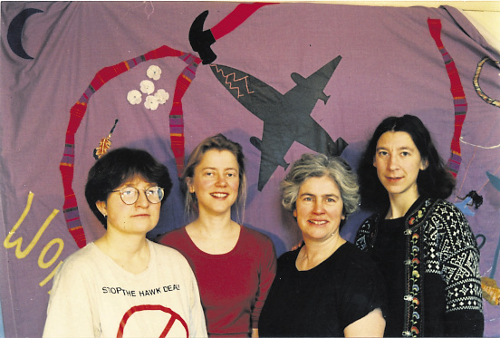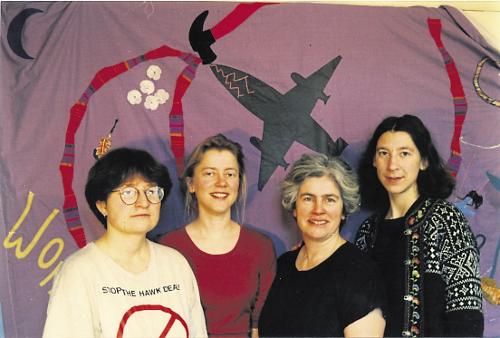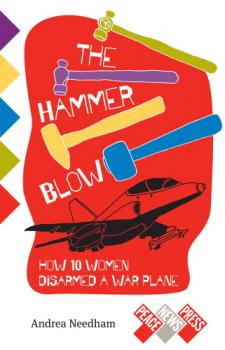

Nobody in my early life – myself included – would have suspected that I had a future as a troublemaker ahead of me. Growing up in rural Suffolk in the 1970s, the youngest of four siblings, there didn’t seem to be much wrong with the world. I don’t recall my family discussing politics, and although my father listened to the news every day, I never paid it much attention.
My interests lay outside: playing with my best friend Louise on her family farm, galloping her ponies round the fields, bike riding through the country lanes. The outside world finally impinged on me in the early 1980s, when I was in the sixth form at school.
The Falklands war started, and I remember thinking that it might be the beginning of something much bigger. I tried not to listen to the news, too scared in case something terrible – the third world war, perhaps – was going to happen. I didn’t question the prevailing narrative: the Argentinians had invaded our islands, and it was right and proper that they be evicted, by force if necessary.
The other political event that I became aware of around that time was the Greenham Common women’s peace camp. Unfortunately I got most of my information about it from my grandfather’s Daily Mail, and was horrified: it seemed like a collection of crazed lesbians (lesbians! we didn’t have them in Suffolk) hanging sanitary towels on the fences of the base.
Physio
From school, I went on to Newcastle upon Tyne Polytechnic to study physiotherapy. I really wanted to be a doctor, but didn’t think I was good enough at science, so chose physiotherapy as a compromise.
I hated physiotherapy. I was a shy, unconfident young woman; I found rapport with patients difficult, and felt uncomfortable with many of the other students, who all seemed sporty and confident and popular, like a public school hockey team. I struggled through to the end, passed my exams and found a job at Kirkwall hospital in Orkney, off the north coast of Scotland, almost as far from Suffolk as it was possible to be without leaving the country.
Orkney was a fantastic place to be; the beauty of the islands, the amazing archaeology, the seabirds, the sense of living on the edge of the world. But having a job I hated overshadowed the wonders of the landscape, and after six months, I resigned.
 I had not the faintest idea what I wanted to do, so I made the decision to go to the USA to spend some time with my sister Siobhan, who was then studying at the University of Indiana in Bloomington.
I had not the faintest idea what I wanted to do, so I made the decision to go to the USA to spend some time with my sister Siobhan, who was then studying at the University of Indiana in Bloomington.
Bloomington was where I took part in my first-ever protest, against the US funding of the Contras of Nicaragua, responsible for grotesque violations of human rights. Siobhan and I walked through the middle of town with a small crowd of others, holding signs and feeling somewhat self-conscious.
My plan was to stay for four months, and to do a bit of travelling. Being short of money (my only income was the few dollars I earned each week for selling blood), I needed to find cheap places to visit. A library book suggested a homeless shelter in Washington DC which accepted live-in volunteers. Perfect: I could do a bit of work, and see the capital for free. I’d stay for three weeks then go home in time for Christmas. As it turned out, the next few weeks would change my life forever.
CCNV
I saw very little of DC during those first weeks; at the Community for Creative Nonviolence, leisure time was looked on as something of an indulgence. The whole operation – a 1,350-bed shelter and a soup kitchen – was run by about 50 live-in volunteers, a mixture of older activists, ex-residents, and idealistic young people like myself. Nobody was paid, and everybody worked far more than full time to keep this enormous ship from running into the rocks.
“I was surrounded by people who had absolutely nothing”
CCNV was set up in 1970 as a community focused on social change and resisting the Vietnam war. A couple of years later they opened a soup kitchen as a way of tackling issues of injustice closer to home, followed by houses of hospitality and a medical clinic. In the 1980s, CCNV occupied an abandoned government building in downtown DC, and later through a long campaign which included prolonged fasting as well as more conventional protests – forced the right-wing administration of President Ronald Reagan to renovate it, to become the huge shelter it was in 1987.
To say it was like nothing I had ever experienced would be an understatement. I had grown up in the country in a middle-class family and attended a grammar school where most children were like me. I had never seen poverty, probably never considered it as something which existed outside of charity appeals for famine relief. Yet here I was, in the capital of one of the richest countries in the world, just a few blocks from the White House, and I was surrounded by people who had absolutely nothing. No home, no money, no food, no health care, nothing. At night, we would often hear gunfire on the streets around the shelter, and occasionally people would stumble through the door still bleeding from gunshot wounds. It would have been hard to find a sharper contrast with the life I had known until that point.
As well as trying to respond to the huge need in front of them, the people at CCNV were organising civil disobedience in support of better conditions for homeless people.
Crossing the line
I arrived in the middle of a campaign to force the transit authority to remove a gate they’d erected at a downtown metro station, Farragut West, to stop homeless people sleeping there. Every night, community members would go down to the station; two people would sit in front of the gates to stop them being closed whilst others sang and held banners. Every night, the people blocking the gates were handcuffed and carried off to a police car. Some time the next day they would return to the shelter, tired and hungry, but ready to head off to the station again that night. I was awestruck: I had never in my life met anyone who had been arrested, and to do it deliberately seemed like the ultimate in self-sacrifice.
Having come to spend three weeks at CCNV, I ended up staying nearly two years, mostly working in the infirmary, a 24-bed unit in the basement of the shelter where we cared for people with often serious – and largely untreated – physical and mental health conditions. It was a chaotic, at times overwhelming, place to work, but at the same time there was something about the place which made me want to stay.
After about a year at CCNV – and perhaps thinking that a day in the cells might be easier than a day in the infirmary – I was arrested for the first time, for taking part in a blockade of Pennsylvania Avenue in protest against cuts in the city housing budget.
Although it was a pretty insignificant action – we carried furniture into the street, then stood holding hands around it as rain fell and traffic hooted – it marked a shift in my life, a step across the line. It was scary, but at the same time exhilarating. As we waited to be arrested we sang: ‘Down by the riverside’ and ‘We shall not be moved’. I felt strong and proud and powerful. It felt like the start of something, although I wasn’t quite sure what.
My curiosity about what happened after you were carted off was soon satisfied: we were taken to a foul underground bunker, DC central lockup, and put into tiny, filthy cells.
We were fed baloney sandwiches and doughnuts with weak coffee and left to spend the night listening to the howling, crying, screaming and puking of the mentally ill, the addicts withdrawing from drugs, the generally desperate people found in prisons everywhere. It was a place of the most appalling pain and desolation, a place for people thrown away by society, there to be processed and labelled and then sent to another place suitable for such nonpeople.
“We were taken to a foul underground bunker, DC central lockup”
Those of us arrested at the protest were all taken to court the next day and released on bail. I went back to the shelter, proudly wearing my plastic wristband, which I kept on for some weeks. I still have it; my name, written in strangely beautiful script, is fading now, but I treasure it as a symbol of my first tiny steps into resistance.
In the end, after a couple of years, I had to leave CCNV. Whilst I felt a strong loyalty to the place, and to many of the incredible people who lived this life permanently, life there had simply become too much for me.
I couldn’t leave DC though: I was on probation for some offence or other and my probation officer was threatening to have me locked up if I left town. A friend suggested I go instead to Dorothy Day House, a Catholic Worker community in the north of the city.
I’d never heard of the Catholic Worker, and was slightly concerned about the religious aspect, but it seemed my only option, so I packed my bags and headed north. It turned out to be a small community of very lovely and committed people, sharing their lives with homeless and refugee families.
The Catholic Worker movement was started in New York in the 1930s, at the time of the Great Depression, by Dorothy Day, a journalist and devout Catholic convert, and Peter Maurin, an itinerant and eccentric French worker-scholar. They initially put out a newspaper, The Catholic Worker (still going strong over 80 years later), which held a strongly pacifist position. Later, houses of hospitality were started, together with farms where people could work the land communally.
Community members lived together with the people they served, in voluntary poverty. Resisting the war machine was an important part of the work of many communities, and remains so today. Nobody is paid for their work and most communities don’t accept government funding; money comes from donations and communal work.
In the US today, there are over 200 Catholic Worker communities, supporting some of the most vulnerable and outcast members of society: homeless people, refugees, prisoners and their families, people with AIDS. It is a truly inspiring movement and one which has now spread to many other countries, including the UK.
At Dorothy Day House, I was introduced to the delights of early morning dumpster-diving at the wholesale vegetable market, twice-weekly cooking of vast pots of food to take onto the streets, and regular peace actions, at the White House, Pentagon, department of energy or other similar sites. When you live in Washington DC, you never have to go far to find somewhere to protest. By now, it felt completely normal to be taking part in protests, watching other people be arrested (having been arrested four times I was becoming a little more circumspect, aware that I was risking deportation), sitting around for hours in court waiting for people to be released, spending time with people who had spent months or years in jail.
Gulf War I
I loved being at Dorothy Day House, but eventually my much-renewed visa ran out, and I had to come home. I moved almost immediately to London, to start a nursing course. It was January 1991, and Britain and the US were about to go to war in Iraq.
On the morning of 17 January, I woke up and turned on the television to see images of missiles hurtling through the black skies above Baghdad and explosions lighting up the streets. Despite all the protests around the world, we had failed to stop this bloody war. It was the first day of my nursing course but I found it almost impossible to concentrate. The war was the only thing on my mind, but none of the other students appeared to care. I urgently needed to find people who felt like I did.
Shortly before the ground war commenced in February, I went down to Whitehall for what had been billed as the ‘Eleventh Hour’ action. I didn’t know anyone there, but it felt like a necessary response to the appalling crimes being committed by my government. When everyone sat down outside Downing Street, I didn’t hesitate: I sat down too, refused to get up, and soon found myself in Bow Street police station, charged with (and later acquitted of) ‘disregarding commissioner’s directions’.
The action had been organised by a group called ‘Gulf War Resisters’. A few days later, there was a meeting to support those who had been arrested, and to talk about where to go next with the campaign. The meeting was at the Peace Pledge Union offices near Euston, in a tiny room up several flights of narrow stairs. I went along with some trepidation, but hoping that these would be the people I was looking for: people who were politically engaged, and committed to resistance. In fact, many of the people I met that day would become close friends through decades of activism. I had found my community.
After the war ended, those of us still in Gulf War Resisters made a decision to stay together as a direct action affinity group, and to change our name. After much deliberation, we settled on ‘ARROW: Active Resistance to the Roots of War’.

